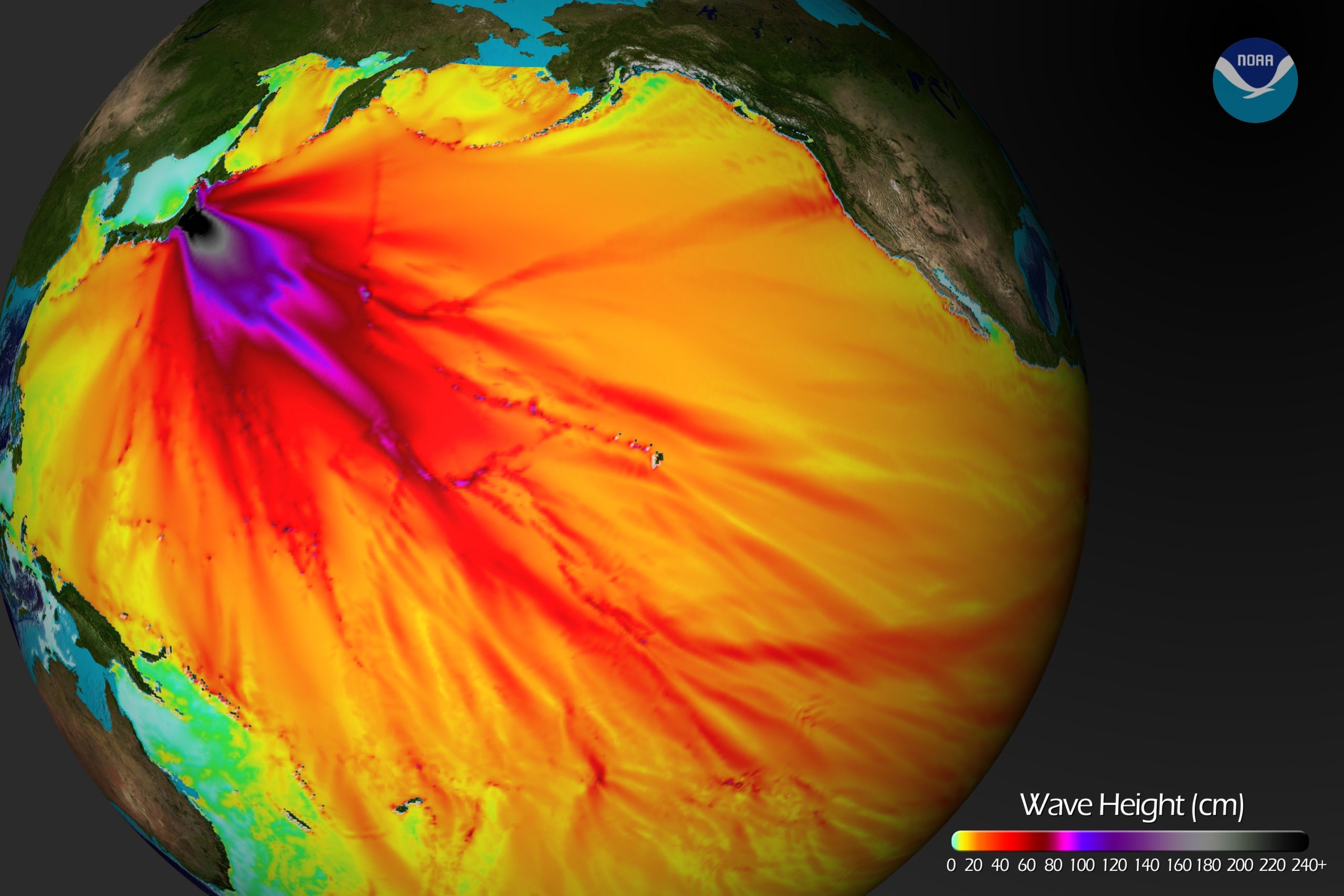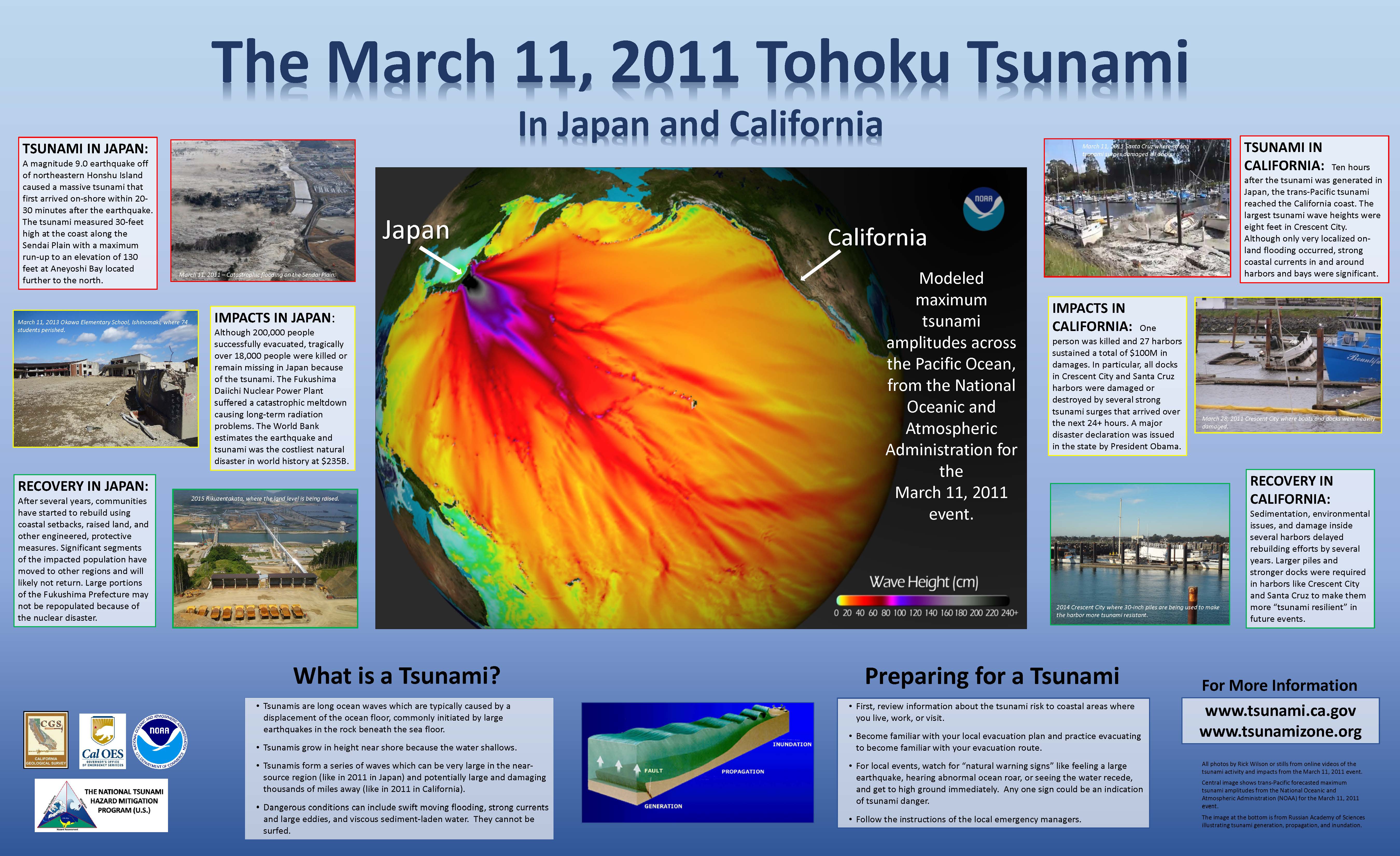Tōhoku-oki Earthquake and Tsunami, March 11, 2011
Tohoku Remembrance TelePortal
The California Tsunami Program supports efforts to increase the resilience to tsunami statewide.
Here is a poster dedicated to the impacts of the Tōhoku tsunami to the coast of California:
Earthquake in Japan

On 11 March 2011 a magnitude M9.1 Great subduction zone megathrust earthquake occurred offshore of eastern Japan.
A subduction zone is a convergent plate boundary where an oceanic plate dives beneath a continental plate.
Here in eastern Japan, the deep-sea Japan Trench is formed by the subduction of the Pacific plate beneath the North America (or Okhotsk) plate.
Over a period of several minutes, the fault slipped over 50 meters (165 feet) causing strong ground shaking and triggering landslides, liquefaction, and tsunami waves.
-
The interactive map below shows:
- earthquake epicenters for large magnitude historic events of the past century
- epicenters for all aftershocks and triggered earthquakes for a year after the M9.1
- an outline of the aftershocks, which is a proxy for visualizing the area of the fault that slipped during the M9.1 earthquake
Zoom and click around to see the magnitudes of different earthquakes.
Earthquake intensity is a measure of how strongly earthquake shaking is felt by people and objects.
The further away from the epicenter, the lower the earthquake intensity is.
Seismologists use computer models to estimate what the intensity will be from an earthquake and these data are plotted on maps using the Modified Mercalli Intensity Scale.
The U.S. Geological Survey uses their “Did You Feel It?” system to collect observations from people about how strongly they felt an earthquake.
The interactive map below displays the USGS intensity model for the M9.1 earthquake as transparent colors.
The map also shows, as colored circles, the “Did You Feel It?” report results from people who experienced shaking from this earthquake.
Zoom and click around to see the level of intensity people felt.
Earthquakes can and do trigger landslides and liquefaction as seismic waves change the physical properties of materials as they travel through the Earth.
A Landslide is caused when the strength of the hillslope materials (“resisting” force) is overcome by the forces from gravity and earthquake shaking (“driving” force).

Liquefaction happens when there are changes in water pressure within the spaces (pores) between sediment particles.

The USGS uses computer models to estimate the chance that an area may have triggered landslides or induced liquefaction.
The California Geological Survey uses similar models to delineate areas prone to ground failure and other earthquake related hazards as part of the Seismic Hazards Program.
The Swipe Map below shows the USGS model for the potential of earthquake triggered landslides on the left and the chance for earthquake induced liquefaction on the right.
-
Additional Resources:
- Learning From Earthquakes
- earthscope
- Wikipedia
Tsunami in Japan

Tsunami are typically caused by changes in the shape of the seafloor by earthquakes or landslides, though can also be caused by bolides (e.g. meteors) or meteorological affects.
During the M9.1 Tōhoku-oki earthquake, hundreds of square kilometers of seafloor were uplifted, displacing the overlying seawater.
This displaced seawater generated large tsunami waves that radiated outwards away from the earthquake source.
These tsunami waves traveled towards the coastline of Japan and across the Pacific Basin to have a significant impact upon coastal communities.
The tsunami waves reached heights of almost 40 meters (130 feet) along the coast of Japan and caused over 18,000 fatalities.
- tsunami size as recorded on tide gages and DART Buoys
- tsunami size as observed by people during or after the tsunami
This interactive map below shows two sets of data.
Zoom and click around to see the observations of the Tohoku-oki tsunami. Click on a colored bar to see more information.
Tsunami in California

The tsunami waves that were sourced offshore of Japan travelled across the ocean to impact many coastal communities in California 10-12 hours after the earthquake.
The federal, state, and local emergency response programs used standard protocol to enact tsunami wave forecasts, public notifications, and evacuation activities.
The waves, recorded by buoys (part of the DART system) and tide gages, helped calibrate the wave forecasts, notifications, and evacuation levels.
In California alone, there was well over $100 million (USD) in damage to coastal infrastructure, primarily in harbors and ports.
The interactive map below can be used to see tsunami waves as recorded by tide gages across the state.
Zoom and click around to see these records.
As part of the California Geological Survey Tsunami Program, when tsunami or coastal flood events occur or are forecast to occur, field teams are deployed to record information from perishable evidence.
CGS sent staff to make direct observations of the tsunami as it reached coastal sites.
Following the Tōhoku tsunami event, CGS helped organize multi-organizational field teams to collect additional information about the spatial extent and magnitude of the effects from the tsunami.
This Coastal Event Response program has been modernized to include digital forms of data collection and web interfaces to share these data in real time.
Case Study – Crescent City
The most severe impact in the state occurred within the small-boat basin at Crescent City Harbor.
Tide gage records show a tsunami maximum amplitude of about 2.5 meters (8 feet), which happened at low tide which minimized the extent of flooding on land.
16 boats sank and 47 others were damaged.
Strong currents peaking at 9 knots, coupled with large sea-level oscillations, caused $28 million (USD) in damage to boats and infrastructure.
Dredging and repairs to the harbor lasted well over a year, but these repairs were made to harden the structures in the harbor, to prevent damage at this scale in the future.
Case Study – Santa Cruz
Based on analysis of videos of the tsunami in the Santa Cruz Harbor, the tsunami wave amplitude was between 1.5 and 2 meters (5 to 6.5 feet).
Using video velocity calculations, speeds of up to about 15 knots were experienced in the Harbor.
14 boats sank and many others were damaged.
23 of the 29 docks sustained significant damage leading to about $28 million (USD) in damage.
Table of statewide damage from Tōhoku

Trans-Pacific Relationships

Following the tsunami in Japan, debris and material washed out to sea often traveled across the Pacific to find a new home along the beaches of the western U.S.
One of these travelers was a boat that found its way to the coast near Crescent City, California in April 2013.
Dr. Lori Dengler, Troy Nicolini, and Vicki Osaki (members of the Redwood Coast Tsunami Workgroup) traveled to Crescent City to investigate this discovery.
A little sleuthing by Dr. Dengler to locate the owners of the boat in Japan led to an enduring international relationship between now sister cities of Rikuzentakata and Crescent City.
Dengler formed a team with Amya Miller (at the time, Special Assistant to the Mayor of Rikuzentakata) and Amy Uyeki (an artist from Arcata, CA) to develop a children’s book.
This story book was also turned into a video story which one can view here:
California Geological Survey Tsunami Program

California Geological Survey Tsunami Unit
- Preparation: Tsunami Hazard Area Maps and Data
- Response: Tsunami and Coastal Flood Event Response Program
- Recovery: CGS is working with partners to develop a tsunami recovery and debris guidance documents for coastal communities.
- Mitigation: CGS has prepared Harbor Improvement Reports so that maritime infrastructure can be designed with tsunami hazard mitigation in mind.


